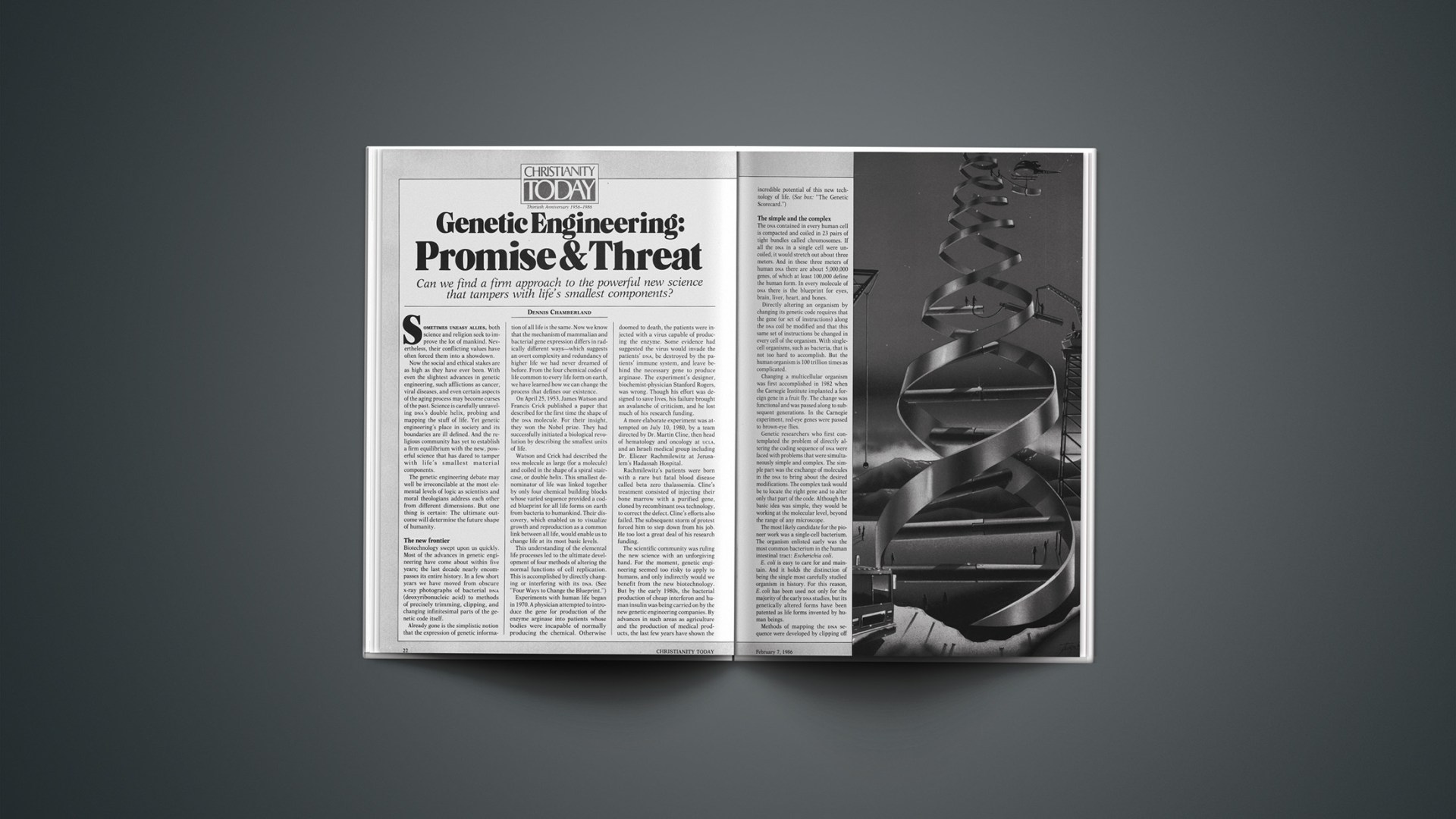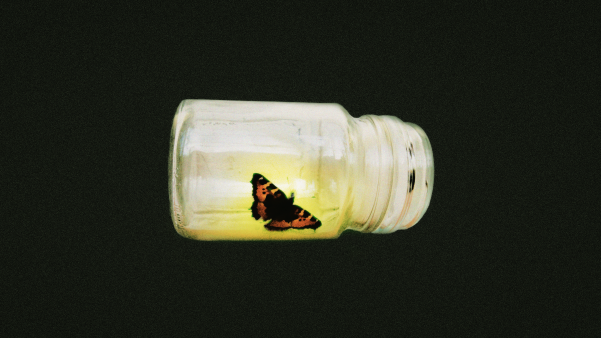Sometimes uneasy allies, both science and religion seek to improve the lot of mankind. Nevertheless, their conflicting values have often forced them into a showdown.
Now the social and ethical stakes are as high as they have ever been. With even the slightest advances in genetic engineering, such afflictions as cancer, viral diseases, and even certain aspects of the aging process may become curses of the past. Science is carefully unraveling DNA’s double helix, probing and mapping the stuff of life. Yet genetic engineering’s place in society and its boundaries are ill defined. And the religious community has yet to establish a firm equilibrium with the new, powerful science that has dared to tamper with life’s smallest material components.
The genetic engineering debate may well be irreconcilable at the most elemental levels of logic as scientists and moral theologians address each other from different dimensions. But one thing is certain: The ultimate outcome will determine the future shape of humanity.
The New Frontier
Biotechnology swept upon us quickly. Most of the advances in genetic engineering have come about within five years; the last decade nearly encompasses its entire history. In a few short years we have moved from obscure x-ray photographs of bacterial DNA (deoxyribonucleic acid) to methods of precisely trimming, clipping, and changing infinitesimal parts of the genetic code itself.
Already gone is the simplistic notion that the expression of genetic information of all life is the same. Now we know that the mechanism of mammalian and bacterial gene expression differs in radically different ways—which suggests an overt complexity and redundancy of higher life we had never dreamed of before. From the four chemical codes of life common to every life form on earth, we have learned how we can change the process that defines our existence.
On April 25, 1953, James Watson and Francis Crick published a paper that described for the first time the shape of the DNA molecule. For their insight, they won the Nobel prize. They had successfully initiated a biological revolution by describing the smallest units of life.
Watson and Crick had described the DNA molecule as large (for a molecule) and coiled in the shape of a spiral staircase, or double helix. This smallest denominator of life was linked together by only four chemical building blocks whose varied sequence provided a coded blueprint for all life forms on earth from bacteria to humankind. Their discovery, which enabled us to visualize growth and reproduction as a common link between all life, would enable us to change life at its most basic levels.
This understanding of the elemental life processes led to the ultimate development of four methods of altering the normal functions of cell replication. This is accomplished by directly changing or interfering with its DNA. (See “Four Ways to Change the Blueprint.”)
Experiments with human life began in 1970. A physician attempted to introduce the gene for production of the enzyme arginase into patients whose bodies were incapable of normally producing the chemical. Otherwise doomed to death, the patients were injected with a virus capable of producing the enzyme. Some evidence had suggested the virus would invade the patients’ DNA, be destroyed by the patients’ immune system, and leave behind the necessary gene to produce arginase. The experiment’s designer, biochemist-physician Stanford Rogers, was wrong. Though his effort was designed to save lives, his failure brought an avalanche of criticism, and he lost much of his research funding.
A more elaborate experiment was attempted on July 10, 1980, by a team directed by Dr. Martin Cline, then head of hematology and oncology at UCLA, and an Israeli medical group including Dr. Eliezer Rachmilewitz at Jerusalem’s Hadassah Hospital.
Rachmilewitz’s patients were born with a rare but fatal blood disease called beta zero thalassemia. Cline’s treatment consisted of injecting their bone marrow with a purified gene, cloned by recombinant DNA technology, to correct the defect. Cline’s efforts also failed. The subsequent storm of protest forced him to step down from his job. He too lost a great deal of his research funding.
The scientific community was ruling the new science with an unforgiving hand. For the moment, genetic engineering seemed too risky to apply to humans, and only indirectly would we benefit from the new biotechnology. But by the early 1980s, the bacterial production of cheap interferon and human insulin was being carried on by the new genetic engineering companies. By advances in such areas as agriculture and the production of medical products, the last few years have shown the incredible potential of this new technology of life. (See box: “The Genetic Scorecard.”)
The Simple And The Complex
The DNA contained in every human cell is compacted and coiled in 23 pairs of tight bundles called chromosomes. If all the DNA in a single cell were uncoiled, it would stretch out about three meters. And in these three meters of human DNA there are about 5,000,000 genes, of which at least 100,000 define the human form. In every molecule of DNA there is the blueprint for eyes, brain, liver, heart, and bones.
Directly altering an organism by changing its genetic code requires that the gene (or set of instructions) along the DNA coil be modified and that this same set of instructions be changed in every cell of the organism. With single-cell organisms, such as bacteria, that is not too hard to accomplish. But the human organism is 100 trillion times as complicated.
Changing a multicellular organism was first accomplished in 1982 when the Carnegie Institute implanted a foreign gene in a fruit fly. The change was functional and was passed along to subsequent generations. In the Carnegie experiment, red-eye genes were passed to brown-eye flies.
Genetic researchers who first contemplated the problem of directly altering the coding sequence of DNA were faced with problems that were simultaneously simple and complex. The simple part was the exchange of molecules in the DNA to bring about the desired modifications. The complex task would be to locate the right gene and to alter only that part of the code. Although the basic idea was simple, they would be working at the molecular level, beyond the range of any microscope.
The most likely candidate for the pioneer work was a single-cell bacterium. The organism enlisted early was the most common bacterium in the human intestinal tract: Escherichia coli.
E. coli is easy to care for and maintain. And it holds the distinction of being the single most carefully studied organism in history. For this reason, E. coli has been used not only for the majority of the early DNA studies, but its genetically altered forms have been patented as life forms invented by human beings.
Methods of mapping the DNA sequence were developed by clipping off the ends of an uncoiled DNA strand and analyzing and identifying the individual molecules as they were encountered on the strand.
After a gene was mapped, changes were induced in the DNA, altering the sequence by introducing mutagenic chemicals—compounds that increase the frequency of genetic mutations by “scrambling” the DNA sequence. Researchers observed the effects on the microorganism, remapped the gene, thereby learning the functions of specific parts of the DNA code.
Recombinant DNA technology, the most refined process of genetic engineering, came in 1974 when genetic researchers discovered they could clip off a known sequence of the DNA and replace it with DNA from other sources. This form of gene splicing quickly became the most important genetic engineering tool. Science was learning enough to make changes at will without relying on the slower random mutational techniques.
Ultimately, geneticists at CalTech invented two machines that were quantum leaps in genetic engineering research. One machine automatically identified the sequence of cellular amino acids, spelling out the DNA code of the particular gene. Another machine assembled artificial genes piece by piece.
With these advances it became necessary for the scientific community to keep track of the avalanche of mapped genes. In 1982, the Los Alamos National Laboratory set up GenBank, a computerized data base of millions of nucleic acid sequences. That data base soon contained information on hundreds of living species—including parts of man’s genetic constitution. One day, reconstructing these genetic constitutions may consist of connecting a laboratory computer to this massive data base, which in turn would spell out the genetic make-up of interest.
It is only a matter of time until the entire human DNA sequence is catalogued and computerized. With this information, the science of genetic engineering may be able to manipulate the human life form in ways we have not yet even imagined.
Four Ways to Change the Blueprint
Mutagenesis
Genetic mutations are induced by introducing a mutagenic agent that increases the random frequency of changes in genes to a rate many times faster than normal. This is usually fatal to the organism. But in populations sufficiently large, an occasional microorganism survives and successfully passes along the changes to subsequent generations.
Protoplast fusion
The external walls of cells are removed from two types of cells. The genetic materials then combine and mix, causing a natural (but still random) genetic recombination.
Gene amplification
DNA (outside the nucleus, but still inside the cell) is forced to reproduce at a rate 100 or more times faster than the DNA inside the nucleus (typically responsible for cell replication). This causes a greatly amplified production of cellular protein.
Recombinant DNA
The most refined genetic manipulation technique consists of splicing specific codes along the DNA chain, forming a stable combination of information that will produce a specific result and pass this trait on to succeeding generations.
Health Care And Big Business
Genetic engineering established a powerful foothold when the U.S. Supreme Court gave Dr. Ananda Chakrabarty the right to patent a life form he had engineered, a microorganism that would metabolize petroleum and help clean up oil spills.
The result of the Court’s decision was to open the field to commercial enterprise. With big money riding on the right processes, a handful of genetic engineering companies went public and became multimillion-dollar enterprises virtually overnight. Firms with futuristic names—Genentech, Cetus, Lenex, Hybratech, Petrogen—started the race to invent new life forms.
The companies signed nearly every genetic scientist and researcher in the field, creating great concern over this historically unique, apparent conflict of interest between industry and pure science.
Three important medical products came from this new industry in quick succession:
Human interferon, a possible solution to such afflictions as cancer and viral diseases, used to cost a quarter of a million dollars per thousandth of a gram. With newly engineered bacteria that produce human interferon as a metabolic by-product, we can now produce the same amount of interferon for about a nickel.
Human growth hormone, for children whose pituitary glands could not produce enough to help them reach a normal height (hypopituitarism), was formerly produced by extracting the hormone from cadavers. An average child required pituitaries from over 500 cadavers over a 10-year period. Thus they were faced with a life of stunted growth unless they could afford $50,000 to $100,000 worth of treatment. Genentech of San Francisco changed the genetic constitution of E. coli, and now human growth hormone is churned out at affordable prices.
Human insulin, now manufactured by genetically altered bacteria for tens of thousands of diabetics, replaces the beef-and pork-based product against which many patients build up antibodies. In October 1982, the Eli Lilly Company was given permission by the Food and Drug Administration to begin marketing human insulin.
But the genetic engineering industry was not focusing on making medical breakthroughs alone. Industrial microorganisms have been “invented” to mine precious metals from ore through extracellular secretions and leaching. A potato was given the blight-resistant genes of a tomato to become a “pomato.” A sunflower was given the genes of a bean to produce protein. One strain of bacteria was engineered to convert ethylene to ethylene glycol (a constituent of antifreeze), another to change subterranean oil to make it easier to remove. And the University of California at Berkeley recently engineered a strain of bacteria that would protect plants from frost, sparking a controversy over introducing the plant into the environment. In November 1985, the EPA finally okayed its release in a California strawberry field.
On the horizon are genetic wonders that used to be mere science fiction. For example, aging is reflected in the behavior of DNA. In pioneering work, Ronald Hart and Richard Setlow tied the biological clock directly to the repair processes in older cells. And in 1979, Dr. Joan Smith-Sonneborn significantly extended the life span of single-cell paramecium by manipulating specific DNA repair processes.
In order to organize the search for cures for the 3,500 known human genetic disorders, the Human Genetic Mutant Cell Repository was established in Camden, New Jersey. Here frozen cell cultures from afflicted individuals are stored for reference.
And serious thought has been given to storing biological materials from organisms soon to be extinct, from smallpox to mammals, birds, and plants, in frozen storage for future, possible genetic reconstruction of entire organisms.
By 1985, the business of genetic engineering was a billion-dollar industry and growing. Already, medicine, agriculture, and energy were becoming dependent on its products, and the emerging possible future uses were astonishing.
Catching Up with the Revolution
Technological events are getting ahead of our ability to cope with them in traditional moral categories. That is reason enough for a Christian moralist to view the revolution in biotechnology with unease.
Rather than apply moral standards to genetic engineering in general, we must examine the moral implications of each discrete stage in the specific applications of biotechnology to human beings. We will need to give careful thought to such questions as these:
1. Is it permissible to alter humanness at its core, to tamper with our essential humanity? Many people agree that it is right to tamper with some aspects of our humanness, as we do in giving people mechanical hearts. But is there a core of humanity that makes us the special godlike creatures we are—a core that should not be monkeyed with? If so, moralists and theologians must try to specify more exactly what is uniquely human about us.
2. Is it permissible for some people to alter other people’s humanity? It is misleading to talk about humanity recreating itself. Some persons are recreating other persons. The questions are these: Who sets the norms for what other people ought to be? And who has the wisdom and the right to use such power over the destiny of other people?
3. Is it socially responsible to give almost free rein to a biotech industry whose bottom line is profit? While some see the National Institutes of Health’s relaxation as a signal that the dangers are small, NIH’s relaxation may actually be a sign that public guardians are easily seduced by scientific authorities. Laissez-faire human technology needs to be watched carefully.
We need to remember that every good gift from above, including biotechnology, is likely to be turned against us by arrogant people who believe in the irresistible goodness of what they are doing.
By Lewis Smedes, professor of theology and ethics at Fuller Theological Seminary.
Benefit And Peril
The first decade of genetic engineering has passed with little threat to the environment or the public. The somber warnings and tight regulations issued by the National Institutes of Health (NIH) from 1974–76 have been relaxed and their initial fears determined to be unfounded.
The NIH, initially worried about the inadvertent design of a deadly microorganism, strictly regulated the genetic engineering business in its infancy. The industry, however, successfully demonstrated that their organisms were usually so task-specific that they could survive only in carefully controlled conditions. One strain of E. coli, called K-12, which is used widely in genetic research, has been so extensively modified that it is virtually impossible for the organism to survive outside a carefully controlled laboratory environment.
To date, the genetic engineering industry has shown itself to be the harbinger only of good, making medicines and food better and cheaper. We have been left in awe at both the reality and the possibilities.
Yet, like any other human enterprise, genetic engineering has a possibility for malevolence equal to its potential for good. For example, since some genetic diseases strike only members of certain races (sickle cell anemia afflicts only blacks, and Tay-Sachs disease strikes only Jews), it is conceivable that we could copy nature and create an organism to carry out a horrible genocide. If biological warfare is terrible, its genetic equivalent would be unspeakable.
Aside from examples of potential abuse, deeply troubling questions remain over the direction civil genetic engineering may take.
Already, in its first years of existence, genetic screening has been used by a multinational corporation in what amounts to high-tech racism.
One multinational corporation defended its use of genetic screening for sickle cell anemia among black job applicants to prevent susceptible workers from exposure to toxic substances. But such genetic screening could become the ultimate invasion of privacy.
On the visible horizon, genetic engineering could be used in conjunction with gametic engineering, the laboratory manipulation of human germ cells, to create a human being in any desired image. In this seriously discussed (but not yet possible) procedure, a human’s genes would be altered to order. The new genetic information would be passed to a human egg cell in vitro, where a new human would be nourished through the gestation period under theoretically perfect conditions. This procedure could hypothetically produce “super humans” resistant or immune to physical disease, and endowed in advance with superior intelligence.
Part of this procedure is now possible. The more difficult procedures will probably be in reach within our lifetimes.
Dr. Landrum Shettles, a reproductive biologist, has reported nourishing a normally developed, cloned human egg cell to the stage of intrauterine impregnation. Said Shettles, the remaining obstacles to the cloning of human beings are social, not scientific.
The first animal cloned, a frog, was produced by biologists Thomas Briggs and Thomas King in 1952. Nearly three decades later, the first mammals were cloned, mice produced by biologists Karl Illmensee and Peter Hoppe. Yet many still believe that cloning by the transplanting of nuclei of adult mammalian cells, as Shettles claimed, is still impossible. The debate continues.
Genetic prejudice is already being expressed. The famous Nobel Sperm Bank, formally called the Repository for Germinal Choice, in Escondido, California, contains sperm donated by some Nobel laureates for insemination of “acceptable” candidates. The only laureate-donor to identify himself thus far has been Stanford physicist William Shockley, who stirred controversy by claiming that blacks are inherently inferior to whites.
The sperm bank’s clients have already produced children. Los Angeles psychologist Afton Blake bore the second child from the bank. One of Blake’s reasons for using the bank’s services was the genetic legacy she wanted to pass on to her children and subsequent generations.
Society’s Toolbox
Some people think of technology, including genetic technology, as society’s toolbox. A new technology is just a new tool, an option for society to use or not as it sees fit. We will make what we want with it. Indeed, if we master enough tools, we may yet construct utopia. When technology fails, we will search for yet another tool to fix it.
That view of technology is naive and, when applied to genetic engineering, dangerous.
First, although technologies are introduced as options, they can quickly become socially enforced. The automobile was introduced as an option—but try to ride a horse home on the interstate. Genetic counseling was introduced to increase options, but already some are insisting that parents have a duty to be informed and, given certain risks, a duty to avoid childbearing.
Second, although technologies are introduced to make things we want, they seldom satisfy our wants. If we can travel faster by car than horse, we now want faster cars. If we can have a child when we could not have one before, we now want a particular kind of child, say a bright, blond boy. Technology is self-stimulating. It is not only a function of our life together and our values, but it also shapes them. Moral wisdom then would call for some sobriety about our limits and our guilt for demanding too much.
Third, although technology has brought real benefits, the confidence that it will always bring well-being (or that, if it doesn’t, some new technology that can correct the harm) is folly. The fundamental problems in coping with human existence do not permit technological solutions; greed, pride, envy, and ennui are not technical problems awaiting a quick technological fix. They too can conscript technology to their ends. As C. S. Lewis wrote: “What we call Man’s power over nature turns out to be a power exercised by some men over others with Nature as its instrument.”
Gametic intervention is a case in point. We are seizing control of reproduction, gaining power to intervene purposefully in the genetic endowment of our children precisely when we are more confused about parenting than ever. The technologies are introduced to increase our options, to get us what we want—a healthy child. But if parenting is to make parents happy, then genetic engineering will go afoul because we will abort whatever or whomever does not meet our specifications—and we shall still be unhappy. And if parenting is to make children happy, then genetic engineering will still go afoul. The awesome responsibility to minimize the children’s suffering and to maximize their happiness will have a self-stimulating impetus until we have reduced our options to a perfect child or a dead child.
Not all reproductive interventions are immoral; but we will not properly guide or limit such powers until we have a good deal more communal wisdom about parenting than we now possess. I fear for our capacities to learn that wisdom in the rush of public enthusiasm about reproductive technologies.
By Alan Verhey, associate professor of religion at Hope College and coeditor with Stephen Lammers of a forthcoming book of theological reflections on medical ethics (Wm. B. Eerdmans).
Moral Imperatives
The scientific community has historically shown itself to be vigorously self-regulated. Its moral standards are nearly always surprisingly conservative. Renegades and apostates are usually criticized and denounced, their research funds cut quickly. It is hard to find many examples of scientists continually abusing their positions.
Remarks made by Robert Sinsheimer of the California Institute of Technology to the Genetics Society of America illustrate this notion: “To impose any limit upon freedom of inquiry is especially bitter for the scientist whose life is one of inquiry; but science has become too potent.… Rights are not found in nature. Rights are conferred within a human society and for each there is expected a corresponding responsibility.… Science is the major organ of inquiry for a society—and perhaps a society, like an organism, must follow a developmental program in which the genetic information is revealed in an orderly sequence.”
From a Christian perspective, the real dangers of genetic engineering do not seem to emanate from the scientific community, but from the same places as other causes of social concern.
The abuse of genetic engineering will come from two familiar directions: (1) ill-defined or nonexistent norms of acceptable social direction and (2) disguised social principles of accomplishing one goal by way of another.
Thus, genetic engineering stands in the same place as the other powerful technologies of history, from nuclear weapons to wonder drugs: controlled completely by the hand of mankind and the conventional or surreptitious operational rules of society. Whatever good or evil shall come from it will be determined through the underlying social motivations and allowances for excess over which Christians may exercise influence.
The Christian response must be controlled by accurate and thorough knowledge of the field and a sober realization that the morality of many of the issues will not be clear-cut or obvious. Most important, we must understand our value systems and decide that what we can do is not necessarily what we should do.
The Christian input will be only one of many. It must be coordinated if the counsel of all those with moral concerns is to be effective.
The opinions of the poorly informed and emotional have already been discounted. The President’s Commission for the Study of Ethical Problems in Medicine and Biomedical and Behavioral Research (1982) stated, “Genetic engineering has become a target for simplistic slogans that try to capture vague fears.”
The concepts that underlie genetic engineering are far from simple. They are some of the most profound and powerful ideas ever. The promise of genetic engineering lies in the miracles that we have already created and will soon invent from the living code. But the nightmare is real and, ironically, is expressed in the words attributed to DNA codiscoverer Sir Francis Crick by journalist David Rorvik:
“No newborn infant should be declared human until it has passed certain tests regarding its genetic endowment.… If it fails these tests, it forfeits the right to live.”
The evil we face, therefore, is not from the tools of life but from the minds that made them. There is only one certainty: The river that is the knowledge of life has been crossed, and we cannot go back again.
The Mandate to Heal
Christians are committed to the biblical mandates to be stewards over the earth and to heal—mandates which give us a theological basis for science.
Many forms of genetic engineering are intended to meet human need and to alleviate human suffering:
First, attempts to control genetic disease: prenatal and postnatal screening, counseling prospective parents who are at risk of producing a genetically defective child, repairing or replacing defective genes and their products. We support these healing goals in general, since genetic technologies give us unique opportunities to alleviate the personal, familial, and social costs of genetic disease. But cautions are raised by possible abuses: coercive, mandatory screenings; discrimination against those identified as “defective”; coercion of some people not to reproduce; and abortion of fetuses considered less than normal. Concerns also arise from enthusiasts who speak of “controlling our own evolution.” We ought to endorse techniques that will prevent or repair the effects of genetic diseases, while rejecting the idea of genetically creating superior individuals in order to transcend the limitations of our finitude.
Second, recombinantDNAresearch: Worries about creating “killer germs” seem to have subsided, but there is still concern that by reshuffling DNA we are overstepping creaturely bounds. This argument is probably inadequate to justify a ban on such beneficial technologies as producing human growth hormone. There is still room for caution in introducing engineered DNA microbes into the environment.
Third, new reproductive technologies: artificial insemination by donor, artificial insemination by husband, and in vitro fertilization. As a general principle, we should accept those technologies that overcome barriers to the unification of the sperm and egg of a husband and wife, whether by artificial insemination or in vitro fertilization. Using donor sperm or egg is problematic, however, since it introduces a “third party” into the procreative act.
Science is a legitimate human enterprise, not a sacred cow. Christians are aware of the human capacity to overreach, exploit, and abuse even in such a worthwhile enterprise as science. To trust in the self-regulation of the scientific community too heavily would be insufficiently cautious about human nature.
By David B. Fletcher, assistant professor of philosophy at Wheaton College, who is currently working on a book on bioethics from an evangelical perspective.










